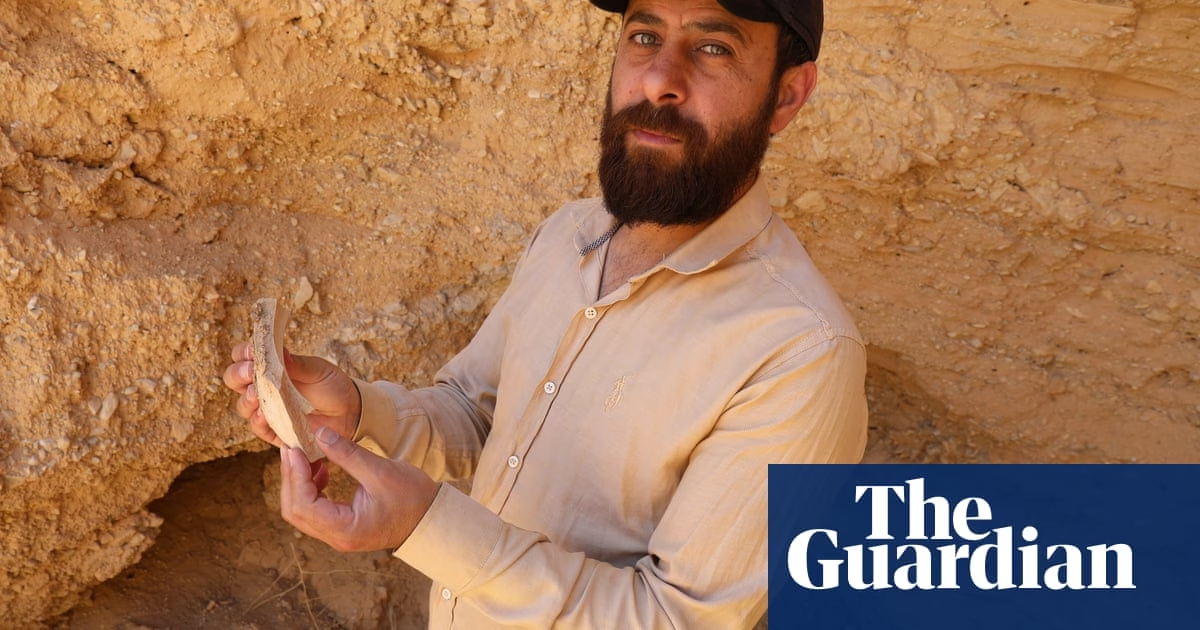By day, the destruction caused by grave robbers is apparent. Three-meter-deep holes mar the landscape of Palmyra, where ancient burial crypts lure people with the promise of funerary gold and ancient artifacts that fetch thousands of dollars.
“These different layers are important, when people mix them together, it will be impossible for archaeologists to understand what they’re looking at,” said Mohammed al-Fares, a resident of Palmyra and an activist with the NGO Heritage for Peace, as he stood in the remains of an ancient crypt exhumed by looters.
He picked up a shattered piece of pottery that tomb raiders had left behind and placed it next to the rusted tailfin of a mortar bomb. Palmyra, which dates back to the third century BC, suffered heavy damage during the period of Islamic State control when militants blew up parts of the ancient site in 2015, deeming its ruins apostate idols.
Palmyra is not the only ancient site under threat. Experts and officials say the looting and trafficking of Syria’s antiquities have surged to unprecedented levels since rebels overthrew the former Syrian President Bashar al-Assad in December, putting the country’s heritage further at risk.
According to the Antiquities Trafficking and Heritage Anthropology Research Project (ATHAR), which investigates antiquities black markets online, nearly a third of the 1,500 Syrian cases it has documented since 2012 have occurred since December alone.
“When the [Assad] regime fell, we saw a huge spike on the ground. It was a complete breakdown of any constraints that might have existed in the regime periods that controlled looting,” said Amr al-Azm, a professor of Middle East history and anthropology at Shawnee State University in Ohio and co-director of the ATHAR project.
The collapse of Syria’s once-feared security apparatus, coupled with widespread poverty, has triggered a gold rush. Located in the heart of the fertile crescent where settled civilization first emerged, Syria is awash with mosaics, statues, and artifacts that fetch top dollar from collectors in the West.
In one post on Facebook in December, a user offered a pile of ancient coins for sale. “I have been holding them for 15 years, Free Syria,” the user wrote.
Katie Paul, a co-director of the ATHAR project and the director of Tech Transparency Project, said:” The last three to four months have been the biggest flood of antiquities trafficking I have ever seen, from any country, ever.”
Paul, along with Azm, tracks the route of trafficked Middle Eastern antiquities online and has created a database of more than 26,000 screenshots, videos, and pictures documenting trafficked antiquities dating back to 2012.
Selling of Looted Antiquities Online
Once out of the ground, antiquities make their way online. Experts say Facebook has emerged as a key hub for the sale of stolen antiquities, with public and private groups offering everything from ancient coins, entire mosaics, and heavy stone busts to the highest bidder.
The ATHAR project provided The Guardian with dozens of screenshots and videos of Syrian antiquities, including mosaics and Palmyran busts, being sold on Facebook groups. A single Facebook search of “antiquities for sale Syria” in Arabic yielded more than a dozen Facebook groups dedicated to trading cultural artifacts, many of them public.
In a March video from a Facebook group, a man with a Syrian accent displays a mosaic depicting Zeus on a throne, using his mobile phone for scale. The mosaic is still in the ground in the video, but later surfaces in another photo, removed from the site. “This is just one of the four mosaics we have,” the man brags.
In other groups, looters have gone on Facebook Live from archaeological sites, asking users for advice where they should dig next and drumming up excitement from potential buyers who tune in.
In 2020, Facebook banned the sale of historical antiquities on its platform and said it would remove any related content. However, according to Paul, the policy is rarely enforced despite continued sales on the platform being well-documented.
“Trafficking of cultural property during conflict is a crime; here you have Facebook acting as a vehicle for the crime. Facebook knows this is an issue,” said Paul. She added that she was tracking dozens of antiquities trading groups on Facebook that have more than 100,000 members, the largest of which has approximately 900,000 members.
A representative from Meta, the parent company of Facebook, declined to respond to The Guardian’s request for a comment.
In Palmyra, Fares is still coming to terms with how much his hometown has changed since returning in December after years of displacement. Broken stones lie at the feet of the Roman-era Arch of Triumph, and the carved faces of sarcophagi in the Tomb of the Three Brothers have been gouged out – all a product of IS iconoclasm.
At night, he and other residents stand guard in the ancient city, determined not to let looters steal what remains of a place already plundered by 15 years of war.







